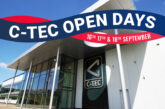
ESP’s new MAGDUO two-wire fire alarm system means easier, faster installations and significant cost savings.
Neil Baldwin, Commercial Director at ESP, takes a look at the range and how it fits into the company’s growing fire protection collection.
As one of the industry’s leading suppliers of security and fire protection solutions, ESP is committed to developing new and improved products that not only bring the latest technologies to market, but are designed to offer speed, flexibility and cost-efficiency to installers working across a range of projects.
The launch of the MAGDUO two-wire fire alarm system adds a totally new collection of products to the company’s growing MAGfire fire protection range. MAGDUO will sit alongside the existing MAG conventional fire alarm products and the MAGPRO addressable range – fulfilling the increasing demand from customers for this latest technology.
Different system types
Fire alarm systems are broadly divided into two main groupings – “conventional” fire alarm systems and analogue addressable “intelligent” systems – with each type best suited to different kinds of premises. Conventional, or four-wire, fire alarm systems are used in smaller properties such as shops and restaurants.
They work by dividing the building into a number of detection zones, with the detectors and call points within each zone hardwired on dedicated two-core cable to the control panel. There may be multiple detectors on a single zone.
A separate two-core, fire-protected cable for the alarm’s sounders is required as they’re wired on different circuits. If a detector is activated, the control panel identifies the circuit that contains the triggered device and so indicates the zone from which the fire alarm has originated, but the area then has to be manually searched to pinpoint the individual device.
Addressable or “intelligent” fire alarm systems are designed for large commercial premises and more complex networked systems. They’re more expensive and complicated than conventional four-wire systems, having increased flexibility, intelligence, speed of identification, and scope of control.
In addressable systems, different types of initiating devices are wired in one or more single loops around the premises, requiring less cabling than conventional systems, with each detector or call point having its own unique address. The fire control panel receives information and status reports from each device and indicates its exact location if there is a fault, contamination or activation via smoke or heat detection.
Because analogue addressable fire alarm systems offer a greater degree of flexibility, intelligence, speed of identification and the extent of control, they’re often the preferred option for specifiers and contractors working on bigger and more intricate projects as they overcome the limitations of conventional fire alarm systems.
Aimed at small and medium contractors
ESP’s MAGDUO two-wire fire alarm system is aimed at small to medium contractors, offering them a highly flexible and adaptable system that will save them time and money on the installation process.
Two-wire fire alarm systems are based on standard conventional system technology. Unlike standard conventional four wired systems where the detectors, call points and alarm devices for each zone are wired on separate circuits, MAGDUO utilises intelligent two-wire technology, which allows all devices to be wired on the same set of two-core zone cables back to the control panel – enabling it to use a single circuit per zone, both for detection and to power the sounders. This advanced technology can reduce both installation and material cost.
The system is ‘two-wire’, meaning that all system devices can be installed on the same circuit with the capacity for up to 32 devices per zone. This, however, is dependent on the Device Loading Unit (DLU). Full information is provided within the product technical specification details. MAGDUO will support 2-8 zone applications.
Features and benefits galore
One key benefit is the Alarm Confirmation feature which offers the ability to select a confirmation period for individual detectors and therefore confirm if the smoke/heat detected is an actual fire – and not a false alarm. Using the built-in alarm confirmation feature, until an alarm has been confirmed within an individual area, only that area is evacuated. At the same time, if an alarm is confirmed in a common area, the device initiates a full alarm evacuating all surrounding areas. This unique conventional panel feature is vital where two-stage alarms are required.
The FlexiPoint detector brings further versatility and convenience to this new range. As well as offering seven different modes of fire detection, including combined heat and smoke, the FlexiPoint detector is also available with an inbuilt sounder or inbuilt sounder strobe, which will assist with a compact install solution (as the detector and sounder is all-in-one as opposed to separate units).
Due to the different options, FlexiPoint offers convenience to installers, as they’ll not be required to carry a complete range of devices.
With its adaptability, speed of installation and cost-effectiveness, MAGDUO provides an ideal fire alarm solution for a range of small to medium sized projects such as restaurants, retail outlets, schools, offices, apartments and hotels. We’re also able to provide training on the new system for those installers that are interested.
For further information on the MAGDUO two-wire fire alarm system visit: www.espuk.com










